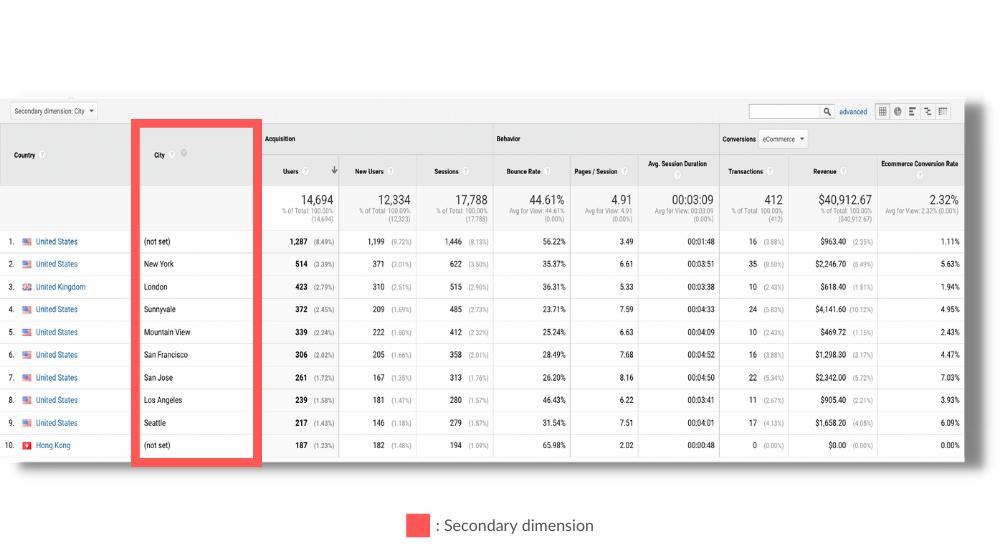Browsing the Midst of Secondary Dimension in Google Analytics: A Thorough Exploration on Its Functionality
Additional dimensions, though relatively straightforward at very first glance, nurture a wealth of untapped prospective waiting to be harnessed. As we begin on this trip to discover the nuanced performance of second measurements, we will certainly discover how this feature can illuminate patterns, reveal relationships, and ultimately pave the means for educated decision-making in the digital landscape (what is a “secondary dimension” in google analytics?).
Understanding Additional Dimensions in Google Analytics

Understanding how additional measurements job is essential for leveraging the full power of Google Analytics. By combining main metrics with additional measurements, you can acquire valuable insights that drive informed decision-making and optimization methods.
Leveraging Additional Dimensions for Data Evaluation
Structure upon the fundamental understanding of how second measurements enhance data analysis in Google Analytics, the use of these added layers of info comes to be critical in extracting important understandings for educated decision-making and optimization approaches. By leveraging secondary measurements, analysts can dig much deeper right into the efficiency metrics by including even more context to the main dimensions, hence revealing covert patterns and connections that may not be obvious at first look. This much deeper level of evaluation enables services to better recognize user habits, identify fads, and pinpoint locations for enhancement.
Furthermore, second dimensions offer a more detailed sight of the information, permitting division based on different criteria such as demographics, devices, web traffic sources, and much more. This segmentation assists in an extra granular analysis, enabling companies to customize their projects and approaches to particular target market sectors for boosted targeting and personalization. Basically, the critical use of additional dimensions encourages companies to make data-driven choices that drive growth and success in the electronic landscape.
Advanced Methods for Secondary Dimension Execution
Discovering intricate techniques to harness the complete potential of secondary dimensions in Google Analytics raises the deepness and refinement of information analysis for critical decision-making. One sophisticated method for applying additional dimensions is the usage of custom dimensions. Furthermore, incorporating additional dimensions with sophisticated sections can give also more granular understandings by applying several layers of segmentation to the data.
Interpreting Insights Through Additional Measurements

When analyzing insights via additional dimensions, it is vital to take into consideration the context of the data and just how different measurements engage with each other. For instance, understanding which particular traffic resources cause higher conversion rates or identifying which gadgets users prefer for making purchases can offer workable insights for maximizing marketing campaigns and enhancing total site performance. By carefully checking out the data with second measurements in mind, services can make educated decisions that drive purposeful results and enhance their electronic presence.
Maximizing Efficiency With Secondary Measurements

One vital way to enhance performance with secondary dimensions is by segmenting data extra granularly. This permits you to isolate details elements address that may content be affecting your metrics and obtain a better understanding of what drives success or failing in your digital efforts. By combining secondary dimensions such as 'gadget group' and 'landing page,' you can determine which tool kinds are most effective for particular touchdown pages, enabling you to tailor your strategies accordingly.
In addition, making use of second dimensions can aid you recognize patterns, patterns, and connections that might not be noticeable when assessing data with main dimensions alone. This deeper level of analysis can cause more educated decision-making and eventually boost the general efficiency of your website or digital advertising campaigns.
Verdict
Finally, secondary measurements in Google Analytics play an essential duty in boosting information analysis and offering deeper insights into internet site performance. By using advanced techniques and translating the data effectively, services can maximize their approaches and boost general performance. Understanding the functionality of secondary dimensions is important for making notified choices and driving success in the digital landscape.
By leveraging additional dimensions, analysts can dive read this article much deeper right into the efficiency metrics by adding even more context to the main measurements, hence discovering surprise patterns and connections that may not be noticeable at very first glimpse. One advanced strategy for implementing additional dimensions is the use of custom measurements.Having mastered innovative strategies like personalized dimensions and regex for second dimension implementation in Google Analytics, the following crucial action is analyzing the valuable insights obtained via these sophisticated data division approaches. Interpreting insights through second measurements entails examining the connections between the primary and second dimensions selected, uncovering patterns, fads, and correlations that may not be instantly apparent when looking at the data in its whole.When analyzing insights with additional dimensions, it is necessary to think about the context of the data and how various dimensions interact with each other.